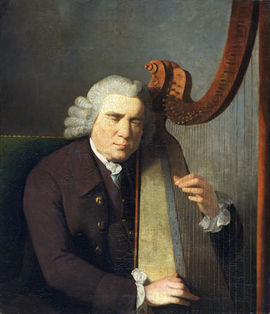Annotation:Nos Galan
X:1 T:Nôs Galan [New Yea's Eve] %written Calan (probably a typo) M:C L:1/8 S:John Parry, British Harmony, London, 1781, p. 7 N:Fleischmann no. 2052 K:G d3 c B2 A2|G2 A2 B2 G2|ABcd c2 BA|G2 ~F2 G4:||: A2 B2 c2 A2|B2 c2 d2 A2|Bc d2 cd e2|=f2 e2 d4| d3 c B2 A2|G2 A2 B2 G2|ABcd c2 BA|G2 ~F2 G4:|
NOS GALAN (New Year's Eve). AKA - "New Years Gift," "Nôs Galan." Welsh, Air (2/4 time). F Major. Standard tuning (fiddle). AAB. This Welsh harp tune fist appears in John ("Blind Parry of Ruabon") Parry's (c. 1710-1782) Twelve Airs for One and Two Guitars, 1781 edition (where it is an untitled air). It was followed by a printing in Edward Jones's (Bardd y Brenin) Musical and Poetical Relicks of the Welsh Bards (1784, p. 159) who gave it the name "Nos Galan," with a lyric in English and Welsh (that seems to have little to do with the holiday). It is ancestral or a precursor to the air for the familiar Christmas carol "Deck the Halls," but originally was a dance tune, the melody providing the musical vehicle for dancers who would circle around, improvising spontaneous lyrics (with the harp playing the tag melody that is now sung as "Fa-la-la-la-la" in the Christmas carol adaptation of the melody "Deck the Halls". In the 19th century other lyrics were added.


